For almost 10,000 years, different types of hot peppers have been cultivated in Americas and after Christopher Columbus’s 1492 voyage they have become cultivated worldwide. Due to various shapes, sizes, flavors, and colors, hot peppers have become an essential ingredient in many cuisines. Read on to find some most notable hot peppers species and varieties, and learn how to grow them indoors to enjoy an abundance of fruits from a single plant.
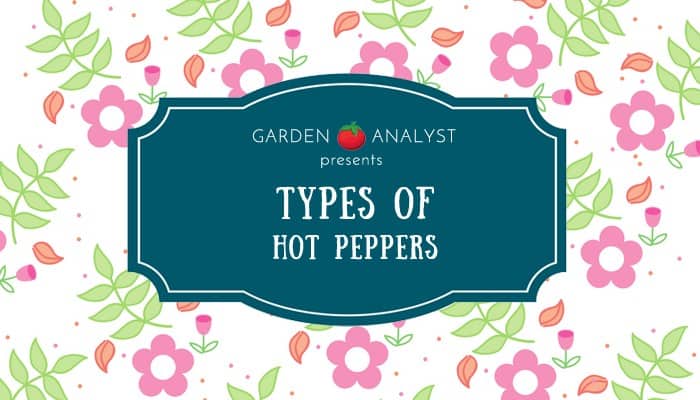
The Intensity of Hot Peppers
Hot peppers or chilli peppers are the fruits of plants that come from the genus Capiscum. The five domesticated species of hot peppers are Capiscum annum, Capiscum frutescens, Capsicum frutescens, Capsicum chinense, Capsicum pubescens, Capsicum baccatum, and they all include hundreds of varieties. Actually, new hybrids are being constantly introduced since many chili growers are trying to create the hottest pepper in the world. The current record holder is The Carolina Reaper.
The intensity of chili peppers’ flavor comes from the substance called capsaicin, which varies significantly among cultivars. When ingested, capsaicin binds to pain receptors in mouth and throat that enable us to sense the heat.
The heat of hot peppers, or concentration of capsaicin, is measured through the Scoville Scale. Scoville heat units (SHU) is actually a measure of the dilution of an amount of chili extract added to sugar syrup before its heat becomes undetectable to a panel of tasters. Simply put, the greater amount of sugar water need to gain the balance, the hotter the pepper. For example, Bell pepper or Sweet Pepper measures 0 SHU. Carolina Reaper measures 2,200,000 SHU, which makes it the current hottest pepper in the world.
Common Types of Peppers
Jalapeño Pepper
Described as spicy, but not overwhelming, this chili pepper is medium-sized with fruits 2-4 in long. It is commonly consumed while still green. Depending on varieties, it has mild to medium intensity, with a range of 1,000 to 20,000 SHU. Chipotle peppers are made out of smoked, ripe jalapeños. It is a key element in Mexican cuisine, and a common ingredient for salsa and various hot dishes, but it is also consumed pickled and stuffed.
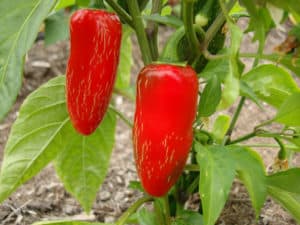
Cayenne Pepper
This Capiscum cultivar usually comes dried in powder form. Cayenne pepper is red and it’s used in spicy dishes, as a powder or as the entire fruit. It also has medical uses due to healing attributes. It is generally rated at 30,000 to 50,000 Scoville units.
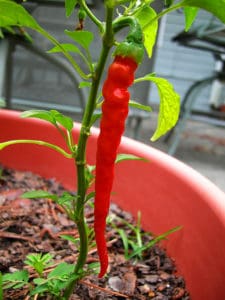
Tabasco Pepper
The tabasco pepper is a variety of chili pepper spices Capsicum frutescens, native to Mexico. It has a Scoville heat index of between 30,000 and 60,000. This is the only ‘juicy’ hot pepper variety because the fruit is not dry on the inside. This hot pepper is best known through its use in widely popular Tabasco sauce.
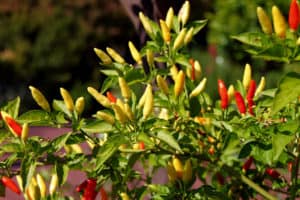
Thai Pepper
The Thai pepper (Bird’s eye chili, Thai chili, Thai dragon) is one of the world’s smallest chili peppers, measuring in at less than an inch. It is an essential ingredient of Thai cooking, but also in Malaysian, Singaporean, Lao, Khmer, Indonesian, and Vietnamese cuisine. Thai pepper has Scoville heat index of between 50,000 and 100,000, which makes it very hot.
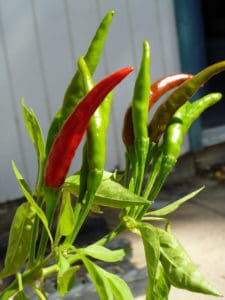
Habanero Pepper
This commonly used, miniature chili pepper (up to 2.4 inches long), but very hot, can be any color from green to red but is usually orange. SHU for the habanero chili can range from 150,000 to 350,000. It is used in Mexican cuisine, and it is very popular ingredient for salsa and other hot sauces or various spicy food.
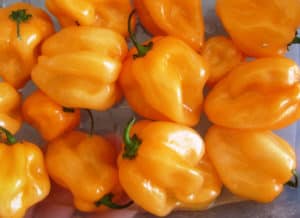
Growing Hot Peppers Indoors
Many chili varieties can be grown in pots indoors, but dwarf ornamental peppers work best for indoor growing, Growing hot peppers indoors is quite challenging, but it may be extremely rewarding if you follow some basic instructions.
Best Climate For Hot Peppers
They can be grown outside in warm climates, but in climate zones where air temperature usually drops bellow 60ºF, they are cultivated in gardens or grown indoors. Though the best environment for growing hot peppers is a greenhouse, you can try to make similar conditions indoors as those in greenhouses to achieve maximum production.
How Much Sun for Hot Peppers
Generally, hot peppers acquire plenty of sun and warmth to germinate and produce healthy fruits. They need at least 6 hours of sunlight a day or 8 hours of indirect light. You can give your peppers a helping hand and place an artificial light 3 inches above the plants. Ideal daytime temperatures are 80-90°F. Nighttime temperatures should be slightly cooler. Hot peppers are not frost-resistant and don’t tolerate extreme heats or temperature drafts.
Consider growing smaller varieties, such as ornamental hot peppers, since they don’t need much room. You can start your hot peppers from seeds or buy a seedling. If you buy a hot pepper seedling in a nursery, you’ll skip a very long process of germinating and avoid common problems related to seed germination stage.
What Type Of Soil for Hot Peppers?
Hot Peppers need a well-drained soil, with plenty of organic matter, but avoid the soil containing peat, because this can prevent peppers from germinating. Don’t fertilize them frequently since overfertilizing can redirect nutrients into leaves and the plant will produce more foliage instead of fruits. Use a fertilizer, balanced in nitrogen, phosphorus, and potassium, but only when the first fruits develop. The plant needs those nutrients to develop better and healthier peppers.
The critical point in growing hot peppers is a flowering stage, so be careful to provide the plant with proper conditions when first flowers appear. Keep the temperature around 70°F and avoid temperature drafts, or the flowers could drop off and leave the plant fruitless. Water it regularly during the flowering stage.
When to Water Hot Peppers?
Water hot peppers whenever the surface of the soil feels slightly dry, but do not overwater it as wet soil may lead to root rot.
As your plant grow, you can harvest hot peppers regularly while the plant continues to bear fruit for several months. You can pick them at any ripeness stage, but hot peppers are most flavorful when they are fully developed. Daily harvesting will encourage more fruit production. Besides, with its foliage and colorful and prominent fruits, hot pepper in a container makes an unusual decorative houseplant.